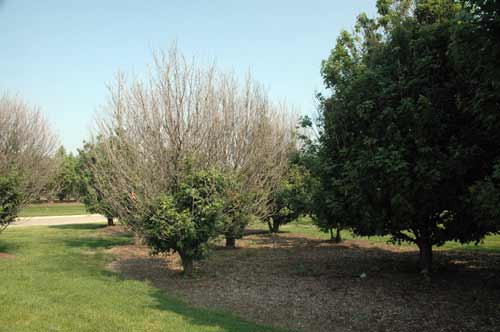Can You Use Glyphosate In Your Garden
, Michigan State University Extension, Departments of Horticulture and Forestry -
Follow these tips to minimize impacts to non-target plants.
Chemical companies are increasingly marketing herbicides directly to homeowners. Herbicides offer a fast and effective way to control weeds and other unwanted vegetation around the home. Applied improperly, however, herbicides also provide an opportunity for a landscape disaster. Here are three simple steps that will help homeowners and other applicators get the most from their herbicides.
1) Know what you're trying to control
As we'll discuss below, there are a wide array of herbicides available at garden centers; some are very selective in what they kill, while others will kill virtually anything green they come in contact with. Are you trying to control dandelions and other broadleaved weeds in your lawn? Are you trying to keep grasses out of a ground-cover bed? Do you want to stop weeds from coming into a bed of annuals? Do you want to keep a paver patio free of all weeds through the summer? Do you want to eliminate poison ivy from areas where kids and pets roam? There are products that, if used properly, can achieve each of these results. But before you pick up a jug of any herbicide, it is essential to know types of weed you're trying to control.
2) Know your herbicide
Applying the right product properly can save time and help produce an attractive weed-free yard. Applying the wrong product can ruin your entire landscape. Herbicides fall into two broad classes: Post-emergent and preemergent.
Preemergent herbicides such as Preen are designed to control weeds as seeds germinate. Preemergents can be very effective in reducing the need to weed annual beds and other parts of the garden. But if you apply Preen to an area where you plant flower or vegetable seeds, you'll be waiting a long time to see anything come up. Post-emergent herbicides, in contrast, kill exiting weeds. Probably the two most familiar post-emergent products are Round-up (glyphosate) and Weed-B-Gon. Glyphosate is a non-selective herbicide that will kill virtually anything green. If you try to spot-spray dandelions in your lawn with Round-up, you will kill the weeds, but you will also have a patch of dead grass around each one. Weed-B-Gon, on the other hand, is a selective herbicide that only kills broadleaved plants but not grasses. This means Weed-B-Gon will take out dandelions and leave the lawn grasses alone. There are also selective herbicides available that do the opposite; that is, they take out grasses but not broadleaved plants.
3) Avoid drift
Once you know what you want to control and have selected the right product, the final step to preventing non-target herbicide damage is to get the product where you want it. Remember, Weed-B-Gon won't kill lawn grasses but it can kill impatiens, petunias and other broad-leaved bedding plants just like it kills dandelions.
To reduce herbicide drift, spray when conditions are as calm as possible. This often means spraying in the early morning or right around sunset. Use the wind forecast feature on the Weather Channel or other weather-related websites to help decide when to spray. Dead calm conditions are rare in Michigan, but avoid spraying if winds are more than about six miles per hour. This may mean waiting a day or two to spray. Also, if you're using a back-pack or pump-up sprayer, reducing the pressure will increase the droplet size and reduce the likelihood of drift.
The ultimate key to eliminating herbicide damage in the landscape, of course, is to read and follow the label directions. Unfortunately, many of us pay as much attention to that disclaimer as we do to airline pre-flight instructions. Reading a label only a takes a few minutes (even allowing for time to find your glasses) but it can save you from doing long-term damage your landscape (Photo 1). The label contains all of the information on which weeds the product will control and how to use it properly. Pay particular attention to any precautionary statements (often in bold print or all caps) and statements listed under "avoiding injury to non-target plants."

Photo 1. These maples were damaged when a non-selective herbicide (Sahara) was applied to landscape beds. Even the product label included a precaution to avoid use near tree roots.
Dr. Cregg's work is funded in part by MSU's AgBioResearch.
Can You Use Glyphosate In Your Garden
Source: https://www.canr.msu.edu/news/getting_the_most_from_landscape_herbicides
Posted by: striplinprivent.blogspot.com

0 Response to "Can You Use Glyphosate In Your Garden"
Post a Comment